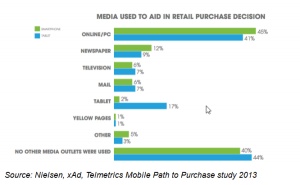by Laurie Sullivan, October 31, 2014

Cross-device targeting relies on anonymous information that transfers from a click like IP address, browser type, latitude and longitude. Along with these attributes, a variety of other things such as ad size allows some technology to make decisions on the ads to serve.
The strategy recently brought two companies together. Magnetic partnered with Tapad because of the increase in mobile traffic from phones and tablets on partner Web sites, but conversions continued to come from desktops. Magnetic needed a way to tell which devices belong to specific consumers, so ad dollars weren’t wasted and produced higher return on investments.
Tapad’s Device Graph Access helps Magnetic’s online search data and media platform assist marketers to reach consumers based on unified, cross-screen behaviors. Companies like Tapad leverage information to detect patterns between connected devices — including browsing, location, and app activity — to determine whether the devices map to the same household and the user.
Let’s say a specific mobile phone moves to the same online location as a laptop every morning at about 9 a.m., and then it moves to another location near a tablet every evening at about 6 p.m. Once the device is mapped to a user, Magnetic cross-references that individual with its audience data and matches that individual to online search behavior.
James Green, Magnetic CEO, said this approach is known as probabilistic. “While not perfect, it’s pretty accurate,” he said. “No one denies, however, that the technology is constantly improving.”
Are there challenges? Green said the obvious challenge is the data isn’t perfect. Therefore, brands should always aggressively optimize campaigns to determine whether or not ads are working on certain devices.
The second challenge is attribution. Those using a last-click attribution model make it more complicated to figure out whether the campaign works or not. It’s important to use a sophisticated attribution model that takes cross-device information into account to determine how the campaign performs.
Even with technical challenges, the method solves a few operational challenges, per Green. “If you are targeting specific audiences, for example, people who are in market for a new car, or new TV, you get the data by looking at Web traffic on computers and then expand the frequency to reach individuals by using cross-device targeting, targeting the audience on their other devices.”
Given that almost all studies, and from Green’s personal experience, say that when you are in market to buy something, you conduct research from multiple devices, using cross-device targeting is an effective way to reach people and unify their experience, a critical component of any modern marketing campaign.
(344)






